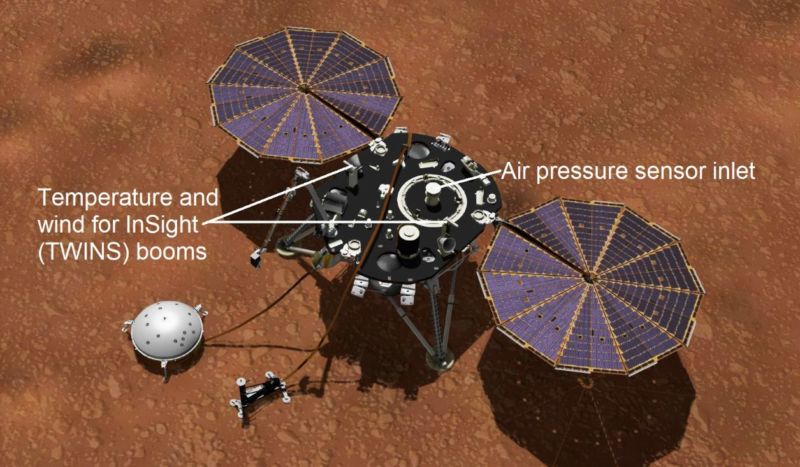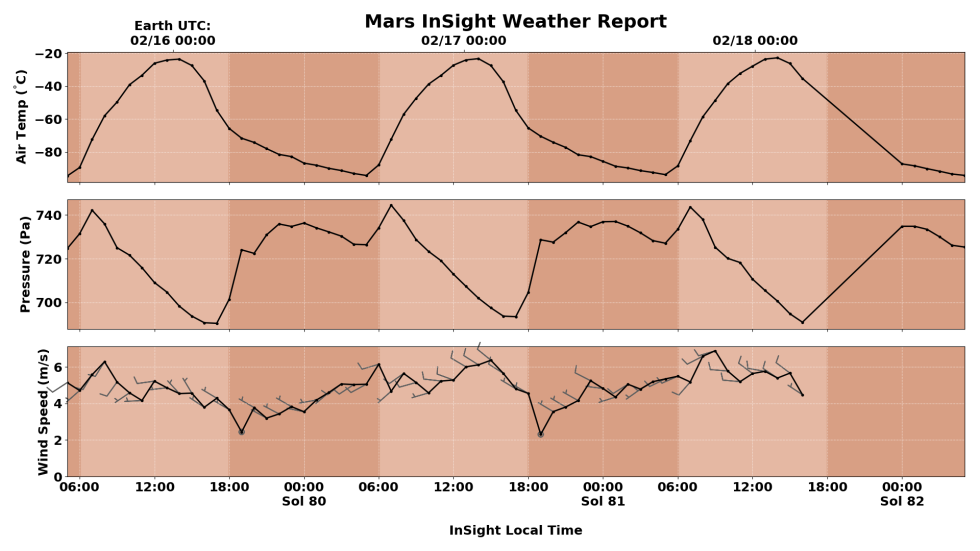
There's a new meteorologist on Mars. Although NASA's InSight spacecraft landed on the red planet late in 2018 to measure the planet's geology—primarily by listening for Mars quakes—it also brought some sophisticated meteorology equipment with it.
The space agency has set up a website to share that information, which includes not only daily high and low temperatures, but unprecedented hourly data on wind speed, direction, and air pressure for InSight's location near the equator in Elysium Planitia. "We thought it was something that people might have some fun with," Cornell University's Don Banfield, who leads InSight's weather science, told Ars.
Other spacecraft have brought comparable temperature and wind sensors to Mars before, but none have carried such a precise air pressure sensor. The new sensor is 10 times more sensitive than any previous instrument because InSight needs to detect slight movements in the Martian ground, and from such movements infer details about the red planet's interior. For this, weather matters.
The Martian atmosphere may be very thin—typically it varies between 700 and 740 pascals at the surface, less than one percent of Earth's surface pressure—but it nonetheless can induce slight tilts in the Martian surface. The air pressure sensor will therefore help scientists calibrate the lander's seismometer so that any tilting due to higher or lower air pressure can be filtered out of the data. It's actually pretty amazing that even so thin an atmosphere can have a slight effect on the Martian surface, and that InSight's seismometer is sensitive enough to detect it.
A Martian mystery
Since InSight landed in November of last year, Banfield and other scientists have been eagerly studying data from the air pressure sensor, and they've made a few discoveries. Some were expected, such as gravity waves in the Martian atmosphere. The instrument has measured these repetitive oscillations in the atmosphere most evenings. Such gravity waves are also observed in Earth's atmosphere, particularly when a uniform air mass is perturbed by a mountain or island.
But scientists have also found something of a mystery in the pressure data on the surface of Mars. Twice a Martian day, at around local 7am and 7pm, there are hiccups in what otherwise should be a smooth rise and fall in surface pressures. Initially, the scientists believed this must be caused by something on the lander, but eventually they were able to rule out a cause due to an instrument anomaly or heating source on InSight.

This feature is repetitive and "slightly strange," said Banfield. It wasn't predicted in any of the global or regional weather models for Mars. Currently, the scientists believe the feature must be some kind of atmospheric wave related to sunrise and sunset on Mars. Perhaps there are downslope air flows moving off steep topography, related to the Sun's movement, that briefly upset the atmospheric changes.
In terms of temperatures and winds, there have been fewer surprises. Martian days aren't too cold, with highs in the range of -10 to -15 degrees Celsius. The nights are bitter cold where InSight is, falling to around -95 degrees Celsius. Winds have not been too surprising, either, although scientists have observed more dust devils than anticipated.
The interplay of dust and wind on Mars remains one of the outstanding questions that scientists like Banfield hope to more fully understand before humans visit the red planet. Dust plays a huge role on Mars in the amount of energy the planet's surface absorbs, and how much it radiates back into space. Scientists also want to understand the minimum winds needed to lift dust off the surface, a necessary precursor for dust devils and dust storms. Banfield said he has built a sensor to make just such measurements, and that he hopes to fly this on a future mission to Mars.
https://arstechnica.com/science/2019/02/some-weird-things-are-happening-with-air-pressure-on-mars/Bagikan Berita Ini














0 Response to "With the best air pressure sensor ever on Mars, scientists find a mystery - Ars Technica"
Post a Comment